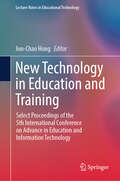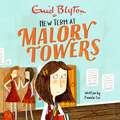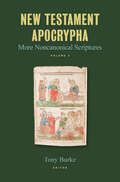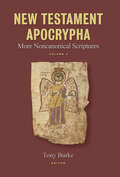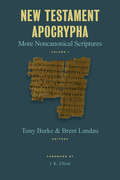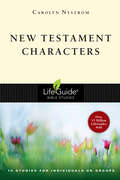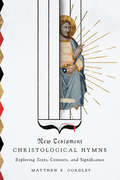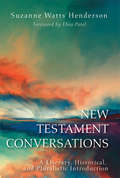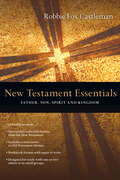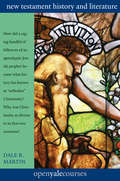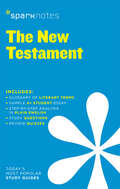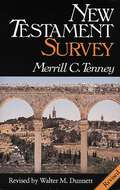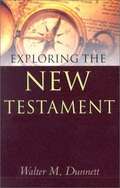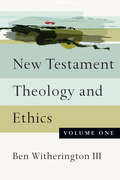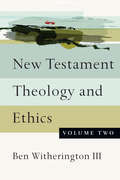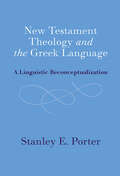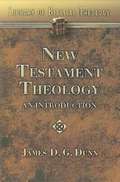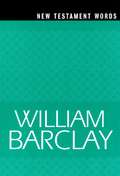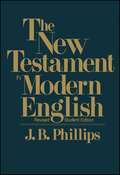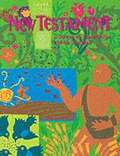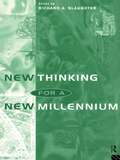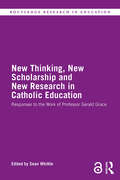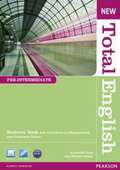- Table View
- List View
New Technology in Education and Training: Select Proceedings of the 5th International Conference on Advance in Education and Information Technology (Lecture Notes in Educational Technology)
by Jon-Chao HongThis book presents the selected papers of the 5th International Conference on Advance in Education and Information Technology (AEIT 2024), which was held in Nagoya, Japan, 2024 January 5-7. With a worldwide increase in technology-enhanced learning in school and industry settings, there has been a progressive increase in the implementation of new technology in education and training. Issues surrounding teaching approaches, classroom management, and the evaluation of learning effectiveness are now considered of global concern. Topics and technical areas covered include but are not limited to: Online/Virtual Laboratories, Classroom and Laboratory Integration, Managed Learning Environments (MLEs), Learning Management Systems (LMS), Collaborative Virtual Environments (CVEs), and Experiences in Educational/Serious Games. This book serves as a useful reference for early career scholars, academics, entrepreneurs and professionals who are working in the field of implementing new technology in education and training.
New Term: Book 7
by Enid BlytonWelcome to Malory Towers, where there's more to life than lessons!Felicity Rivers is excited to be Head Girl of the third form and there are three new girls to help settle in this term. But Felicity's in for a shock when someone starts playing spiteful tricks. The girls suspect an old enemy is to blame - how will they find out for sure?Expect more drama at Malory Towers!Malory Towers is now a fantastic television drama, available on BBC iPlayer and on CBBC.Between 1946 and 1951, Enid Blyton wrote six novels set at Malory Towers. Books 7-12 are authorised sequels of the series written by Pamela Cox in 2009 and focus on the adventures of Felicity Rivers, Susan Blake, and June Johns. This edition is unillustrated.*Malory Towers ®, Enid Blyton ® and Enid Blyton's signature are registered trade marks of Hodder & Stoughton Limited. No trade mark or copyrighted material may be reproduced without the express written permission of the trade mark and copyright owner.
New Term: Book 7 (Malory Towers #37)
by Enid BlytonWelcome to Malory Towers, where there's more to life than lessons!Felicity Rivers is excited to be Head Girl of the third form and there are three new girls to help settle in this term. But Felicity's in for a shock when someone starts playing spiteful tricks. The girls suspect an old enemy is to blame - how will they find out for sure?Expect more drama at Malory Towers!Malory Towers is now a fantastic television drama, available on BBC iPlayer and on CBBC.Between 1946 and 1951, Enid Blyton wrote six novels set at Malory Towers. Books 7-12 are authorised sequels of the series written by Pamela Cox in 2009 and focus on the adventures of Felicity Rivers, Susan Blake, and June Johns. This edition is unillustrated.*Malory Towers ®, Enid Blyton ® and Enid Blyton's signature are registered trade marks of Hodder & Stoughton Limited. No trade mark or copyrighted material may be reproduced without the express written permission of the trade mark and copyright owner.
New Term: Book 7 (Malory Towers #7)
by Enid BlytonWelcome to Malory Towers, where there's more to life than lessons!Felicity Rivers is excited to be Head Girl of the third form and there are three new girls to help settle in this term. But Felicity's in for a shock when someone starts playing spiteful tricks. The girls suspect an old enemy is to blame. How will they find out for sure? Between 1946 and 1951, Enid Blyton wrote six novels set at Malory Towers. Books 7-12 are authorised sequels of the series written by Pamela Cox in 2009 and focus on the adventures of Felicity Rivers, Susan Blake, and June Johns. This edition is unillustrated.(P) 2019 Hodder & Stoughton Limited Malory Towers ®, Enid Blyton ® and Enid Blyton's signature are registered trade marks of Hodder & Stoughton Limited. No trade mark or copyrighted material may be reproduced without the express written permission of the trade mark and copyright owner.
New Testament Apocrypha: More Noncanonical Scriptures
by Edited by Tony BurkeAn expansive compilation of New Testament apocrypha in English translation, featuring fascinating but heretofore unpublished texts. New Testament Apocrypha, vol. 3, continues the More New Testament Apocrypha series&’ quest to unearth the vast diversity of Christian scripture outside of the traditional canon. This new collection encompasses a broad range of languages—Greek, Church Slavic, Old English, Coptic, and more—and spans centuries, from the formation of the canonical New Testament to the high Middle Ages. The selections here represent some of the least studied apocryphal texts, many of which have not previously received an English translation or even a critical edition. Notable newly edited and translated selections include the Martyrdom of Zechariah, the Decapitation of John the Forerunner, the Birth of John, the Revelation about the Lord&’s Prayer, and the Dialogue of Mary and Christ on the Departure of the Soul. Each text is accompanied by a robust introduction, bibliography, and notes. Scholars of apocrypha, Scripture, and hagiography from a breadth of disciplines will find this an indispensable reference for their research and teaching.Contributors:Carson Bay, Mark G. Bilby, Rick Brannan, Christian H. Bull, Slavomir Čéplö, Alexander D&’Alisera, Gregory Given, Nathan J. Hardy, Brandon W. Hawk, Stephen C. E. Hopkins, Alexander Kocar, Brent Landau, Jacob A. Lollar, Christine Luckritz Marquis, Ivan Miroshnikov, Tobias Nicklas, Samuel Osborn, Stephen Pelle, Bradley Rice, Julia A. Snyder, Janet E. Spittler, James Toma, Peter Tóth, Sarah Veale, J. Edward Walters, Charles D. Wright, Lorne R. Zelyck
New Testament Apocrypha: More Noncanonical Scriptures
by Tony BurkeA compilation of apocryphal Christian texts, many translated into English for the first time, with comprehensive introductions.This second volume of New Testament Apocrypha continues the work of the first by making available to English readers more apocryphal texts. Twenty-nine texts are featured, including The Adoration of the Magi and The Life of Mary Magdalene, each carefully introduced, copiously annotated, and translated into English by eminent scholars. These fascinating texts provide insights into the beliefs, expressions, and practices of a range of Christian communities from the early centuries through late antiquity and into the medieval period.
New Testament Apocrypha: More Noncanonical Scriptures
by Tony BurkeCompilation of little-known and never-before-published apocryphal Christian texts in English translation This anthology of ancient nonbiblical Christian literature presents informed introductions to and readable translations of a wide range of little-known apocryphal texts, most of which have never before been translated into any modern language. An introduction to the volume as a whole addresses the most significant features of the writings included and contextualizes them within the contemporary study of the Christian Apocrypha. The body of the book comprises thirty texts that have been carefully introduced, copiously annotated, and translated into English by eminent scholars. With dates of composition ranging from the second century CE to early in the second millennium, these fascinating texts provide a more complete picture of Christian thought and expression than canonical texts alone can offer.
New Testament Characters (LifeGuide Bible Studies)
by Carolyn NystromA throwaway womanA blind beggarA prison guardA doubting discipleAn elderly couple®PDF download with a single-user license; available from InterVarsity Press and other resellers.
New Testament Christological Hymns: Exploring Texts, Contexts, and Significance
by Matthew E. GordleyWe know that the earliest Christians sang hymns. Paul encourages believers to sing "psalms, hymns, and spiritual songs." And at the dawn of the second century the Roman official Pliny names a feature of Christian worship as "singing alternately a hymn to Christ as to God." But are some of these early Christian hymns preserved for us in the New Testament? Are they right before our eyes? New Testament scholars have long debated whether early Christian hymns appear in the New Testament. And where some see preformed hymns and liturgical elements embossed on the page, others see patches of rhetorically elevated prose from the author's hand. Matthew Gordley now reopens this fascinating question. He begins with a new look at hymns in the Greco-Roman and Jewish world of the early church. Might the didactic hymns of those cultural currents set a new starting point for talking about hymnic texts in the New Testament? If so, how should we detect these hymns? How might they function in the New Testament? And what might they tell us about early Christian worship? An outstanding feature of texts such as Philippians 2:6-11, Colossians 1:15-20, and John 1:1-17 is their christological character. And if these are indeed hymns, we encounter the reality that within the crucible of worship the deepest and most searching texts of the New Testament arose. New Testament Christological Hymns reopens an important line of investigation that will serve a new generation of students of the New Testament.
New Testament Conversations: A Literary, Historical, and Pluralistic Introduction
by Suzanne Watts HendersonHistorical introductions to the New Testament typically devote careful attention to its ancient context, exploring these texts against the backdrop of Jewish and Hellenistic thought. But biblical scholars have been slower to appreciate the pluralistic setting in which students of all ages read the New Testament today.Students today bring to the study of the New Testament an increasing sense that its message, while dominant in the Western world for millennia, is now just one voice among many religious (and philosophical) options. In this book, students encounter the New Testament in relation to the wider landscape of sacred traditions—both ancient and contemporary. What is more, they will reflect on the ways in which both writers and interpreters adopt, adapt, and elaborate on common views and practices in their own cultural settings. Rather than a repository of doctrinal beliefs, the New Testament emerges as a lively conversation partner in the human quest for meaning and purpose.Several features distinguish The New Testament Conversation from other introductions to the New Testament. The book combines standard historical and literary scholarship on New Testament writings—presented in the body of the work—with selected excerpts from non-Christian traditions. In addition, students will encounter diverse interpretations of selected New Testament passages across time and place. Finally, this book presents historical, literary, and theological questions as mutually illuminating, rather than oppositional. This book describes the New Testament’s contents as inherently religious responses to the realities of the Roman world—both in occupied Palestine and beyond. Jesus appears in these texts as a savior who is apocalyptic prophet, messianic figure, and community organizer. As a divinely-sanctioned agent of God’s coming reign, Jesus elicits allegiance to a divine, rather than human, ruler in ways that carry both religious and socio-political implications. Thus, more than other books, this textbook highlights the communal context and implications of each writing.
New Testament Essentials: Father, Son, Spirit and Kingdom (The Essentials Set)
by Robbie F. CastlemanA memory verseA Bible studyA readingA life application section"Connecting to the Old Testament" feature
New Testament History and Literature
by Dale B. MartinIn this engaging introduction to the New Testament, Professor Dale B. Martin presents a historical study of the origins of Christianity by analyzing the literature of the earliest Christian movements. Focusing mainly on the New Testament, he also considers nonbiblical Christian writings of the era. Martin begins by making a powerful case for the study of the New Testament. He next sets the Greco-Roman world in historical context and explains the place of Judaism within it. In the discussion of each New Testament book that follows, the author addresses theological themes, then emphasizes the significance of the writings as ancient literature and as sources for historical study. Throughout the volume, Martin introduces various early Christian groups and highlights the surprising variations among their versions of Christianity.
New Testament SparkNotes Literature Guide (SparkNotes Literature Guide Series #47)
by SparkNotesNew Testament SparkNotes Literature Guide Making the reading experience fun! When a paper is due, and dreaded exams loom, here's the lit-crit help students need to succeed! SparkNotes Literature Guides make studying smarter, better, and faster. They provide chapter-by-chapter analysis; explanations of key themes, motifs, and symbols; a review quiz; and essay topics. Lively and accessible, SparkNotes is perfect for late-night studying and paper writing. Includes:An A+ Essay—an actual literary essay written about the Spark-ed book—to show students how a paper should be written.16 pages devoted to writing a literary essay including: a glossary of literary termsStep-by-step tutoring on how to write a literary essayA feature on how not to plagiarize
New Testament Survey
by Merrill C. TenneyFirst published in 1953 and revised in 1961, Merrill Tenney's comprehensive survey has served to introduce the general reader, student, and teacher to the world and message of the New Testament. Written in a clear, nontechnical style, New Testament Survey begins with a survey of the social, political, economic, and religious background of the New Testament, and then goes on to examine the various groups of New Testament books, which are considered in their historical settings. The book concludes with a penetrating study of the New Testament canon. Undertaken at the request of Dr. Tenney, and prepared with his full approval, this 1985 revision by Walter M. Dunnett includes an entirely new chapter on the Jewish background of the New Testament, plus several new short sections, including materials on the Gospels and the canon of the New Testament. The bibliography has been enlarged and updated, and many of the book's numerous illustrations, maps, and charts are new. Great care has been exercised to retain the spirit and quality of the original work, ensuring that the book will remain a standard in the years to come.
New Testament Survey
by Walter M. DunnettAn introduction to the New Testament, used in conjunction with the Hadley School for the Blind's survey course by the same name.
New Testament Theology and Ethics (New Testament Theology And Ethics Ser. #Volume 1)
by Ben Witherington IIIAll too often, argues Ben Witherington, the theology of the New Testament has been divorced from its ethics, leaving as isolated abstractions what are fully integrated, dynamic elements within the New Testament itself. As Witherington stresses, "behavior affects and reinforces or undoes belief." Having completed commentaries on all of the New Testament books, a remarkable feat in itself, Witherington now offers the first of a two-volume set on the theological and ethical thought world of the New Testament. The first volume looks at the individual witnesses, while the second examines the collective witness. The New Testament, says Ben Witherington, is "like a smallish choir. All are singing the same cantata, but each has an individual voice and is singing its own parts and notes. If we fail to pay attention to all the voices in the choir, we do not get the entire effect. . . . If this first volume is about closely analyzing the sheet music left to us by which each musician's part is delineated, the second volume will attempt to re-create what it might have sounded like had they ever gotten together and performed their scores to produce a single masterful cantata." What the New Testament authors have in mind, Witherington contends, is that all believers should be conformed in thought, word and deed to the image of Jesus Christ--the indelible image.
New Testament Theology and Ethics (New Testament Theology and Ethics #Volume 2)
by Ben Witherington IIIAll too often, argues Ben Witherington, the theology of the New Testament has been divorced from its ethics, leaving as isolated abstractions what are fully integrated, dynamic elements within the New Testament itself. As Witherington stresses, "behavior affects and reinforces or undoes belief." Having completed commentaries on all of the New Testament books, a remarkable feat in itself, Witherington now offers the second of a two-volume set on the theological and ethical thought world of the New Testament. The first volume looks at the individual witnesses, while the second examines the collective witness. The New Testament, says Ben Witherington, is "like a smallish choir. All are singing the same cantata, but each has an individual voice and is singing its own parts and notes. If we fail to pay attention to all the voices in the choir, we do not get the entire effect. . . . [If the first volume was] about closely analyzing the sheet music left to us by which each musician's part is delineated, [this second volume attempts] to re-create what it might have sounded like had they ever gotten together and performed their scores to produce a single masterful cantata." What the New Testament authors have in mind, Witherington contends, is that all believers should be conformed in thought, word and deed to the image of Jesus Christ--the indelible image.
New Testament Theology and the Greek Language: A Linguistic Reconceptualization
by Stanley E. PorterIn this book, Stanley E. Porter offers a unique, language-based critique of New Testament theology by comparing it to the development of language study from the Enlightenment to the present. Tracing the histories of two disciplines that are rarely considered together, Porter shows how the study of New Testament theology has followed outmoded conceptual models from previous eras of intellectual discussion. He reconceptualizes the study of New Testament theology via methods that are based upon the categories of modern linguistics, and demonstrates how they have already been applied to New Testament Greek studies. Porter also develops a workable linguistic model that can be applied to other areas of New Testament research. Opening New Testament Greek linguistics to a wider audience, his volume offers numerous examples of the productivity of this linguistic model, especially in his chapter devoted to the case study of the Son of Man.
New Testament Theology: An Introduction (Library of Biblical Theology)
by James D. DunnIn this volume in the Library of Biblical Theology series, James D.G. Dunn ranges widely across the literature of the New Testament to describe the essential elements of the early church’s belief and practice. Eschatology, grace, law and gospel, discipleship, Israel and the church, faith and works, and most especially incarnation, atonement, and resurrection; Dunn places these and other themes in conversation with the contemporary church’s work of understanding its faith and life in relation to God’s self-revelation in Jesus Christ.
New Testament Words
by William BarclayBarclay traces the meaning of New Testament words in classical Greek, in the Septuagint, in Hellenistic Greek, and in the papyri. This volume covers all the words originally explained in Barclay's A New Testament Wordbook and More New Testament Words, and it includes an index providing access, by both Greek and English, to every mention of these words in The Daily Study Bible.
New Testament in Modern English
by J. B. PhillipsThe New Testament in JB Phillips' own translation, bringing home to the modern reader the full force of the original message. The full text and introductions of J B Phillips' New Testament in Modern English. Originally written for the benefit of his youth group the demands of others led to the publication of this modern English translation. The language is up to date and forceful, involving today's reader in the dramatic events and powerful teaching of the New Testament so as to bring home the message of Good News as it was first heard two thousand years ago.
New Testament: A Course on Jesus Christ and his Disciples
by Norman F. Josaitis Michael J. LanningThis is a student's guide to the great study of the fundamental beliefs of the Christian faith.
New Thinking for a New Millennium: The Knowledge Base of Futures Studies
by Richard A. SlaughterIn this book, Richard Slaughter draws on the relatively new but rapidly developing field of futures studies to illustrate how our thinking must change in order to deal with the challenges presented by the new millennium. In doing so he brings together the latest work from some of the leading international names in futures thinking. Part One considers the foundations of futures thinking in history, literature and ideas. Part Two explores some of the ways that futures studies have been and are being applied in different educational contexts around the world, from pre-school to postgraduate levels. Part Three takes the crucial step from institutional learning to social learning, and explores how futures provides us with insights which can help guide our society into the new millennium, together with suggestions for the development of the field itself. This book is essential reading for teachers, students and anyone interested in the perils and promise of the twenty-first century.
New Thinking, New Scholarship and New Research in Catholic Education: Responses to the Work of Professor Gerald Grace (Routledge Research in Education)
by Sean WhittleNew Thinking, New Scholarship and New Research in Catholic Education gives a forum to many established and leading scholars to review and critically appraise the research contribution of Gerald Grace to Catholic education. The book demonstrates the way in which the field of Catholic Education Studies has developed under the influence of Grace, to become internationally recognised. This book demonstrates the ways in which Gerald Grace has shaped Catholic education since 1997. This begins with the primacy of empirical study and carefully conducted fieldwork when researching Catholic education. Many contributors focus on the way Grace champions the alignment between Catholic education and what we have come to know as the option for the poor. The collection also reflects Grace's intention to ensure the voices of women are properly represented in the field of Catholic education. The book is based on an inclusive and open principle that seeks to establish dialogue with educators of different faiths and different religious backgrounds, as well as secular and humanist critics. It will be of great interest to academics, scholars and students of religious education, the history of education and all those interested in the developing field of Catholic Education Studies.
